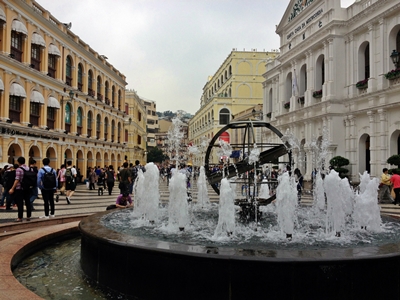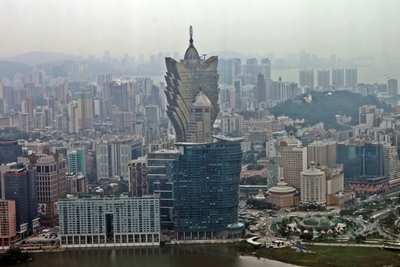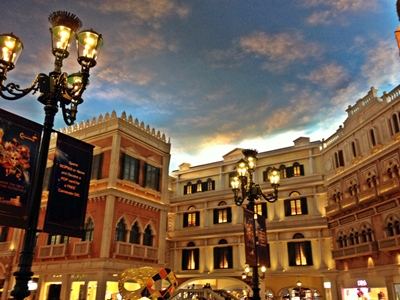Non-Gambling Side of Macau

There are more Filipinos in Macau than in Batanes. They are everywhere in the 30-square-kilometer former Portuguese colony that is now a part of China.
A thriving workforce numbering between 30,000 and 50,000, the Filipino workers in Macau welcome tourists at the airport, open doors at hotels, cook and wait at restaurants, serve in households and work in banks and offices.
A Macau resident of Spanish descent admires Filipinos for their hard work, while citing the role of Macau in providing employment to Filipino migrants.
"Our government is giving the Philippines a big hand. We are not discriminating against Filipinos," says Maria Eugenia Lam Hernandez Leong, president of Macau Tourist Guide Association.
Maria, as she introduces herself to tourists, says Filipinos can be found in hundreds of hotels, casinos and restaurants all over Macau, a special administrative region in China that is composed of the Macau peninsula, the islands of Taipa and Coloane as well as the reclaimed area.
Maria knows the ins and outs of Macau tourism industry and in her work as tourist guide for four decades, she says she has constantly huddled with Filipinos to provide guests with the best service available in Macau.

Macau is like a big theme park, with the neon lights of giant casinos glowing at night. During the day, the city’s modern architecture blends well with 18th century churches, temples and edifices.
In these establishments work thousands of Filipinos, who earn three times as much as they do back in their home country. Filipinos in Macau shine for their humility and hard work, and many guests prefer to stay in hotels with Filipino staff such as Sofitel Macau at Ponte 16 because they speak English. Macau residents only speak Cantonese and a dialect called Macanese Portuguese and find it difficult to communicate with foreigners, including other Asians.
The most senior among tourist guides in Macau with 39 full years of working experience,
Maria says she values her Filipino friends. "I go to their homes and sing with them," she says.
The vivacious Maria, who was born in Guatemala to a Spanish mother and Chinese father, arrived in Macau in 1970, became a tourist guide in 1974 and has helped the Portuguese trading port attract tourists from all over the world since then.
“I have been working here for 39 years,” she says. She speaks five languages and is a most sought after tourist guide, catering to English and Spanish-speaking guests. She has welcomed ordinary tourists as well as celebrities and politicians from countries like the Philippines.
"I remember a famous family from the Philippines who went to the Venetian Macau Resort Hotel and came home with 10 shopping bags. To them, money is not a problem," she recalls. Venetian is known for its hundreds of boutiques carrying luxury brands.
Filipinos working in hotels and restaurants in Macau, the richest country in Asia in terms of per capita GDP, earn 6,000 to 8,000 Macau Pataca or an equivalent of P30,000 to P40,000 a month. “That is beside the tip,” says a staff at a Korean-owned restaurant in Taipa. At the exchange rate, the Pataca, the local currency of Macau, is traded at P5 apiece.
Although Macau's major attractions remain the 33 casinos such as the Venetian, City of Dreams, Wynn Resorts, Sands, Grand Lisboa, Galaxy Rio and MGM Macau, Maria says there is more to Macau that non-gamblers can enjoy.
In fact, casino is the last thing that Maria recommends to her guests. “The number one destination in Macau for me is St. Paul’s. The last would be the casinos,” she says.
The Ruins of St. Paul's is the most visited historic site in Macau although what remains standing is the facade of what was originally the Church of Mater Dei which was built by the Jesuits in 1602 but was destroyed by fire in 1835. The ruins of St. Paul's College stand adjacent to the church.
Maria admires many Filipinos for going to Macau just for sightseeing. “Many Filipinos are coming here and they do not gamble,” she says.

Maria, however, acknowledges that the casinos like the Venetian are the ones bringing in the money. Gambling revenues reached $38 billion in 2012, eclipsing Las Vegas’ $10.8 billion.
“Macau has a lot of money,” she says. “Our government provides 15 years of free mandatory education and healthcare. We also have public housing.”
In 2012, some 28 million tourists came to Macau, which had a population of just over 500,000. Many of these tourists came from Hong Kong and mainland China. Five million tourists arrived by planes, exceeding the total number of visitor arrivals in the Philippines, a country of over 100 million.
“Our population is 550,000, and 470,000 are residents. The rest are workers,” says Maria.
Arrivals from the Philippines alone exceed 100,000 a year, and many Filipinos come during the summer months of April and May to escape the heat in the Philippines. The average temperature in Macau (22.7 degrees Celsius) is about four degrees cooler than in the Philippines (26.6 degrees).
Aside from St. Paul’s, Maria takes her guests to a tour of Senado Square, a public venue paved with wave-patterned stone mosaic. It is also famous for its souvenir shops and stores.
She also brings guests to the 338-meter Macau Tower, which provides a panoramic view of Macau and Pearl River Delta. Some Filipinos dare to bungee jump from the observation deck, considered as the highest in the world.
Maria also recommends a tour of the Handover Museum, Macau Giant Panda Pavillion in Coloane as well as the old fishing village of Taipa and a little store of egg tart called Lord Stowe’s Cafe.
Aside from gambling, the giant casinos have interesting features such as the luxury boutiques at the Venetian and the House of Dancing Water show at the City of Dreams.
Maria says another big attraction in Macau is the food, ranging from traditional Chinese cuisine to Portuguese to a fusion of both called Macanese. Most restaurants have Filipino staff, such as
O Porto Interior, Antonio’s on Taipa Island, 360 Macau Tower Revolving Restaurant, Beijing Kitchen at City of Dreams and Escada near the Senado Square.

The Michellin-recommended Antonio’s Restaurant on Rua dos Negociantes in the old quarters of Taipa has Filipino staff. Chef Antonio Neves Coelho’s wife is also Filipino.
Maria is a relentless promoter of Macau as a tourist destination, not only for gamblers but also for those who would like to witness “east meets west” architecture.
Her three children, the eldest being 33, asked Maria to retire from work. “But what would I do if I stay at home?” she says.
“I wish I was 30 years younger, so I can still help Macau tourism,” she says.
Temperature in Macau is about 5 degrees cooler than in the Philippines. It is located about 65 kilometers west of Hong Kong and 1,150 kilometers northwest of the Philippines.
Macau can be reached in less than two hours from Manila. Cebu Pacific has daily flights between Manila and Macau. Its 150-seater A319 flight leaves Manila at 7:30pm and arrives in Macau at 9:30pm. The return flight departs from Macau at 10:15pm and arrives at 12:15am the following day.
Cebu Pacific also flies from Cebu and Clark to Macau.